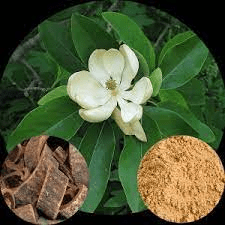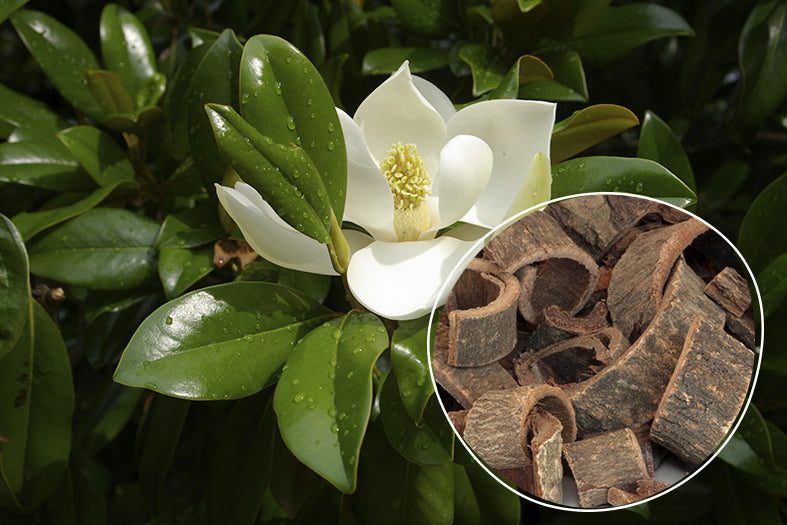Magnolia bark is derived from various species of the Magnolia genus. Especially Magnolia officinalis and Magnolia obovata, has been an integral component of traditional medicine systems, particularly in East Asia.
These species belong to the Magnoliaceae family and are valued for their therapeutic properties.
One of the key bioactive compounds found in magnolia bark is honokiol. Honokiol is recognized for its anxiolytic and sedative effects, making magnolia bark a popular remedy for stress and anxiety in traditional medicine.
It is believed to interact with neurotransmitter systems, such as GABA receptors, influencing mood and promoting a sense of calm.
In addition to its potential anxiolytic properties, magnolia bark is also studied for its anti-inflammatory effects. The compounds honokiol and magnolol exhibit anti-inflammatory activity, suggesting potential applications in conditions associated with inflammation.
This anti-inflammatory action may contribute to the traditional use of magnolia bark in addressing inflammatory conditions.
Moreover, magnolia bark has been investigated for its role in supporting sleep. The calming effects of honokiol may extend to promoting relaxation and improving sleep quality. Research suggests that magnolia bark extracts may influence the sleep-wake cycle and help individuals with sleep disorders.
Beyond mental health and sleep support, magnolia bark is also being explored for its potential antioxidant properties. Antioxidants help protect cells from oxidative stress and may have implications for overall health and well-being.
The antioxidant activity of magnolia bark compounds contributes to its traditional use as a general health tonic.
It’s important to note that while magnolia bark has a rich history in traditional medicine and shows promise in preclinical studies, more research is needed to establish its efficacy and safety in various health applications.
As with any herbal remedy, individuals should consult with healthcare professionals, especially if they are pregnant, nursing, or taking other medications, to ensure safe and appropriate use. Ongoing scientific investigations into the pharmacological effects of magnolia bark may further uncover its therapeutic potential.
The Botanical Description of Magnolia Bark
1. Leaf Arrangement: Magnolia trees typically exhibit alternate leaf arrangement on their branches.
2. Flower Structure: Magnolia flowers are often large, showy, and come in various colors, including white, pink, and purple.
3. Bark Texture: The bark of magnolia trees is smooth, with a grayish-brown hue, contributing to its visual appeal.
4. Growth Habit: Magnolia species can vary in growth habit, ranging from shrubs to towering trees.
5. Fruit Characteristics: The fruit of the magnolia tree is a cone-like structure, housing seeds within its protective covering.
6. Leaf Shape: Magnolia leaves are commonly obovate or elliptical, showcasing a glossy green color.
7. Fragrance: Some magnolia species are renowned for their fragrant flowers, emitting a pleasant aroma.
8. Size: The size of magnolia trees can vary widely, with some reaching impressive heights and others remaining more compact.
9. Bloom Time: Magnolia trees typically bloom in spring, gracing landscapes with their vibrant flowers.
10. Root System: Magnolia trees often develop a robust root system, contributing to their stability and longevity.
The Geographic Distribution of Magnolia Bark

1. North America: Magnolia trees are native to parts of North America, particularly in the southeastern United States.
2. Asia: Several magnolia species are indigenous to various Asian countries, including China and Japan.
3. Central America: Magnolia trees thrive in the diverse climates of Central American regions.
4. South America: Certain magnolia species are found in South American countries, contributing to the botanical richness of the region.
5. Europe: While not as prevalent, magnolia trees can be found in select regions of Europe, cultivated for their ornamental value.
6. Africa: Some magnolia species are adapted to specific African climates, adding to the continent’s biodiversity.
7. Australia: Magnolia trees have been introduced and cultivated in certain parts of Australia.
8. India: Magnolia species are present in various parts of India, contributing to the country’s diverse flora.
9. Middle East: In specific Middle Eastern climates, magnolia trees find suitable conditions for growth.
The Chemical Composition of Magnolia Bark
1. Honokiol: Known for its anti-inflammatory and antioxidant properties, honokiol is a major bioactive compound in magnolia bark.
2. Magnolol: This compound possesses anti-anxiety and anti-inflammatory effects, contributing to the medicinal benefits of magnolia bark.
3. Eudesmol: Eudesmol exhibits antimicrobial properties, enhancing the overall therapeutic potential of magnolia bark.
4. Pinene: Aromatic and anti-inflammatory, pinene is a terpene found in magnolia bark.
5. Camphene: This compound contributes to magnolia bark’s aroma and may have therapeutic effects.
6. Caryophyllene: With anti-inflammatory properties, caryophyllene is a key component in magnolia bark.
7. Linalool: Known for its calming effects, linalool adds to the potential anxiolytic properties of magnolia bark.
8. Terpinolene: This terpene offers antioxidant and potential anticancer benefits.
9. Myrcene: Myrcene contributes to the sedative effects of magnolia bark and has anti-inflammatory properties.
10. Flavonoids: Magnolia bark contains various flavonoids, known for their antioxidant and anti-inflammatory effects.
11. Alkaloids: Certain alkaloids present in magnolia bark may have analgesic and anti-anxiety properties.
12. Phenolic Compounds: Phenolic compounds contribute to the overall antioxidant capacity of magnolia bark.
Read More: 20 Medicinal Health Benefits Of Night Blooming Cactus (Epiphyllum oxypetalum)
The Medicinal Health Benefits Of Magnolia Bark (Magnolia genus)

1. Anxiety Relief: Magnolia bark has anxiolytic properties, aiding in the management of anxiety disorders.
2. Anti-Inflammatory Effects: Compounds like honokiol and magnolol contribute to the anti-inflammatory properties of magnolia bark.
3. Sleep Aid: Magnolia bark may promote better sleep quality and help alleviate insomnia.
4. Stress Reduction: The anxiolytic effects of magnolia bark extend to stress reduction, promoting overall well-being.
5. Antioxidant Support: The presence of flavonoids and other compounds provides antioxidant support, combating oxidative stress.
6. Neuroprotective Properties: Magnolia bark may have neuroprotective effects, potentially benefiting cognitive function.
7. Anti-Cancer Potential: Some compounds in magnolia bark exhibit anti-cancer properties, showing promise in cancer research.
8. Cardiovascular Health: Magnolia bark may contribute to cardiovascular health by supporting normal blood pressure and cholesterol levels.
9. Anti-Bacterial Effects: Certain components in magnolia bark display antibacterial properties, aiding in the fight against infections.
10. Digestive Support: Magnolia bark may help soothe digestive issues and promote gastrointestinal health.
11. Anti-Allergic Properties: Magnolia bark may have anti-allergic effects, assisting in the management of allergic reactions.
12. Anti-Asthmatic Effects: Some studies suggest that magnolia bark may offer relief to individuals with asthma.
13. Anti-Diabetic Potential: Magnolia bark may play a role in managing diabetes by influencing insulin sensitivity.
14. Liver Health: Compounds in magnolia bark may contribute to liver health, supporting detoxification processes.
15. Anti-Aging Benefits: The antioxidant properties of magnolia bark may contribute to anti-aging effects on the skin.
16. Pain Management: Magnolia bark may have analgesic effects, providing relief from various types of pain.
17. Anti-Depressant Properties: The anxiolytic effects of magnolia bark may extend to potential anti-depressant benefits.
The Methods of Usage to Achieve the Provided Health Benefits Of Magnolia Bark (Magnolia genus)
1. Magnolia Bark Tea: Steeping magnolia bark in hot water to create a soothing tea is a popular method for anxiety and stress relief.
2. Tinctures: Extracting the beneficial compounds into alcohol or glycerin solutions allows for easy and controlled dosage.
3. Capsules and Supplements: Magnolia bark supplements offer a convenient way to incorporate its health benefits into daily routines.
4. Essential Oil: The essential oil derived from magnolia bark can be used in aromatherapy for relaxation and stress reduction.
5. Topical Creams: Magnolia bark-infused creams can be applied to the skin for localized relief of pain and inflammation.
6. Inhalation: Inhaling the aroma of magnolia bark, whether through essential oils or other forms, may provide calming effects.
7. Powdered Form: Magnolia bark powder can be added to smoothies or food for an easy and palatable consumption method.
8. Magnolia Bark Extract: Concentrated extracts can be taken directly or added to beverages for a potent dose of health benefits.
9. Traditional Chinese Medicine (TCM): Magnolia bark has a long history of use in TCM, where it may be prescribed in various formulations.
10. Herbal Combinations: Combining magnolia bark with other complementary herbs can enhance its therapeutic effects for specific health concerns.
The Side Effects Of Using Magnolia Bark Medicinal Plant
1. Drowsiness: Excessive consumption may lead to drowsiness, so it’s advisable to avoid operating heavy machinery after use.
2. Gastrointestinal Upset: Some individuals may experience stomach discomfort or nausea when using magnolia bark.
3. Allergic Reactions: Allergic responses, though rare, can occur, especially in individuals sensitive to plant compounds.
4. Drug Interactions: Magnolia bark may interact with certain medications, so it’s crucial to consult with a healthcare professional if on prescription drugs.
5. Pregnancy and Breastfeeding: Pregnant and breastfeeding individuals should exercise caution and consult with a healthcare provider before using magnolia bark.
6. Low Blood Pressure: Magnolia bark’s potential to lower blood pressure may be a concern for individuals with already low blood pressure.
7. Sedation: The calming effects of magnolia bark may lead to sedation, impacting alertness.
8. Hormonal Effects: Some compounds in magnolia bark may influence hormone levels, requiring monitoring in certain individuals.
9. Liver Health: Individuals with liver conditions should use magnolia bark cautiously, as it may impact liver enzymes.
10. Blood Clotting: Magnolia bark may have antiplatelet effects, potentially impacting blood clotting, so caution is advised for individuals with bleeding disorders.
11. Respiratory Depression: Excessive use may contribute to respiratory depression, particularly when combined with other depressants.
12. Skin Sensitivity: Direct skin contact with magnolia bark or its extracts may cause skin sensitivity or irritation in some individuals.
Read More: The Benefits and Uses of Blueberry Fruits
The Scientific Research and Studies of Magnolia Bark

1. Anxiolytic Effects: Studies indicate that magnolia bark, particularly honokiol and magnolol, may exhibit anxiolytic effects, contributing to stress and anxiety relief.
2. Neuroprotective Properties: Research suggests that magnolia bark may have neuroprotective properties, potentially benefiting neurological disorders.
3. Anti-Inflammatory Activity: Compounds in magnolia bark have demonstrated anti-inflammatory effects, indicating potential applications in inflammatory conditions.
4. Antioxidant Capacity: Magnolia bark’s antioxidant properties have been observed in various studies, highlighting its ability to combat oxidative stress.
5. Sleep Improvement: Magnolia bark’s influence on GABA receptors may contribute to improved sleep quality and duration.
6. Anti-Cancer Potential: Some studies explore the anti-cancer potential of magnolia bark compounds, showing promising results in preclinical models.
7. Anti-Diabetic Effects: Research suggests that magnolia bark may influence insulin sensitivity, offering potential benefits in diabetes management.
8. Cardiovascular Health: Studies have investigated the impact of magnolia bark on cardiovascular health, including blood pressure regulation and cholesterol management.
9. Anti-Bacterial Properties: Certain compounds in magnolia bark exhibit antibacterial effects, providing support in combating microbial infections.
10. Anti-Asthmatic Effects: Preliminary research suggests that magnolia bark may have anti-asthmatic effects, warranting further exploration in respiratory conditions.
The Safety Precautions and Recommendations In Using Magnolia Bark Medicinal Plant
1. Dosage Guidelines: Adhere to recommended dosage guidelines to avoid potential side effects or toxicity.
2. Consultation with Healthcare Professionals: Individuals with pre-existing medical conditions or those taking medications should consult healthcare professionals before using magnolia bark.
3. Pregnancy and Breastfeeding: Pregnant or breastfeeding individuals should seek medical advice before incorporating magnolia bark into their health regimen.
4. Monitoring Blood Pressure: Regular monitoring of blood pressure is advisable, especially for individuals with hypertension.
5. Allergic Sensitivity: Individuals with known plant allergies should exercise caution and perform a patch test before using magnolia bark.
6. Driving and Operating Machinery: Due to potential sedative effects, it’s advisable to avoid activities that require heightened alertness after consuming magnolia bark.
7. Interactions with Medications: Magnolia bark may interact with certain medications, highlighting the importance of informing healthcare providers of its use.
8. Liver Health Monitoring: Individuals with liver conditions should monitor liver function while using magnolia bark, as it may impact enzyme levels.
9. Duration of Use: Prolonged use of magnolia bark should be monitored, and breaks in usage may be advisable to prevent tolerance or dependency.
10. Children and Elderly: Caution should be exercised when considering magnolia bark for children or the elderly, and dosage adjustments may be necessary.
11. Quality of Products: Choose high-quality magnolia bark products from reputable sources to ensure purity and efficacy.
12. Reporting Adverse Effects: Any adverse effects or unexpected reactions should be reported to healthcare professionals promptly for proper assessment.
FAQs About Magnolia Bark Medicinal Plant
1. Is magnolia bark safe for long-term use?
Magnolia bark is generally considered safe for short to moderate-term use. However, long-term use may require monitoring for potential side effects.
2. Can magnolia bark be used during pregnancy?
Pregnant individuals should consult with healthcare professionals before using magnolia bark due to potential effects on pregnancy.
3. Are there specific contraindications for magnolia bark use?
Individuals with liver conditions, low blood pressure, or those taking specific medications should exercise caution and seek medical advice before using magnolia bark.
4. How does magnolia bark interact with medications?
Magnolia bark may interact with medications, particularly those affecting the central nervous system or blood pressure. Consultation with healthcare providers is essential.
5. Can magnolia bark be used for children?
The use of magnolia bark in children should be approached with caution, and dosages should be adjusted based on age and weight.
6. What is the recommended dosage of magnolia bark?
Dosage recommendations can vary based on the form of magnolia bark and individual factors. Following product instructions or consulting with healthcare professionals is advisable.
7. Does magnolia bark have psychoactive effects?
Magnolia bark is not known for psychoactive effects. Its primary actions are attributed to its influence on neurotransmitters and physiological processes.
8. Can magnolia bark be used for skin conditions?
Magnolia bark extracts may have potential benefits for certain skin conditions, but direct skin contact should be approached cautiously to avoid sensitivity or irritation.
9. Can magnolia bark help with sleep disorders?
Yes, magnolia bark’s influence on GABA receptors and its calming properties may contribute to improved sleep quality. However, individuals with sleep disorders should consult healthcare professionals for personalized advice.
10. How can magnolia bark be incorporated into daily routines?
Magnolia bark can be consumed as tea, taken in supplement form, used in aromatherapy, or applied topically through creams. The choice depends on individual preferences and health goals.
11. Is magnolia bark part of traditional medicine practices?
Yes, magnolia bark has a history of use in traditional medicine, including Traditional Chinese Medicine (TCM), where it is often prescribed for various health concerns.
12. Can magnolia bark be beneficial for mental health?
Magnolia bark’s anxiolytic and stress-relieving properties suggest potential benefits for mental health. However, individuals with mental health conditions should consult with healthcare professionals for comprehensive guidance.
13. Are there any age restrictions for using magnolia bark?
While there are no strict age restrictions, caution should be exercised when considering magnolia bark for children and the elderly. Dosages may need adjustment based on age and individual health.
14. Can magnolia bark be combined with other herbs?
Yes, magnolia bark can be combined with other complementary herbs to enhance its therapeutic effects for specific health concerns. However, interactions and contraindications should be considered, and consultation with healthcare professionals is advisable.
15. How does magnolia bark contribute to anti-aging benefits for the skin?
The antioxidant properties of magnolia bark may help combat oxidative stress, which is a contributing factor to skin aging. Incorporating magnolia bark into skincare routines or using magnolia bark-infused products may support overall skin health.
Read Also: How to Choose the Right Trash Service for Your Needs

